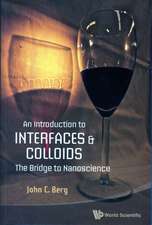Treatise on Solid State Chemistry: Volume 6B Surfaces II
Editat de N. Hannayen Limba Engleză Paperback – 11 oct 2011
| Toate formatele și edițiile | Preț | Express |
|---|---|---|
| Paperback (4) | 394.44 lei 38-44 zile | |
| Springer Us – 26 oct 2011 | 394.44 lei 38-44 zile | |
| Springer Us – 11 oct 2011 | 399.67 lei 6-8 săpt. | |
| Springer Us – 12 dec 2012 | 427.97 lei 6-8 săpt. | |
| Springer Us – 19 iun 2012 | 670.82 lei 6-8 săpt. |
Preț: 399.67 lei
Nou
Puncte Express: 600
Preț estimativ în valută:
76.48€ • 80.05$ • 63.65£
76.48€ • 80.05$ • 63.65£
Carte tipărită la comandă
Livrare economică 31 martie-14 aprilie
Preluare comenzi: 021 569.72.76
Specificații
ISBN-13: 9781461343189
ISBN-10: 1461343186
Pagini: 436
Ilustrații: XIV, 418 p.
Dimensiuni: 170 x 244 x 23 mm
Greutate: 0.69 kg
Ediția:Softcover reprint of the original 1st ed. 1976
Editura: Springer Us
Colecția Springer
Locul publicării:New York, NY, United States
ISBN-10: 1461343186
Pagini: 436
Ilustrații: XIV, 418 p.
Dimensiuni: 170 x 244 x 23 mm
Greutate: 0.69 kg
Ediția:Softcover reprint of the original 1st ed. 1976
Editura: Springer Us
Colecția Springer
Locul publicării:New York, NY, United States
Public țintă
ResearchDescriere
The last quarter-century has been marked by the extremely rapid growth of the solid-state sciences. They include what is now the largest subfield of physics, and the materials engineering sciences have likewise flourished. And, playing an active role throughout this vast area of science and engineer ing have been very large numbers of chemists. Yet, even though the role of chemistry in the solid-state sciences has been a vital one and the solid-state sciences have, in turn, made enormous contributions to chemical thought, solid-state chemistry has not been recognized by the general body of chemists as a major subfield of chemistry. Solid-state chemistry is not even well defined as to content. Some, for example, would have it include only the quantum chemistry of solids and would reject thermodynamics and phase equilibria; this is nonsense. Solid-state chemistry has many facets, and one of the purposes of this Treatise is to help define the field. Perhaps the "most general characteristic of solid-state chemistry, and one which helps differentiate it from solid-state physics, is its focus on the chemical composition and atomic configuration of real solids and on the relationship of composition and structure to the chemical and physical properties of the solid. Real solids are usually extremely complex and exhibit almost infinite variety in their compositional and structural features.
Cuprins
of Volume 6B.- 1 Catalysis by Solid Surfaces.- 1. Introduction.- 2. Historical Development of the Understanding of Catalysis.- 2.1. A Chronology.- 2.2. The Steady-State Surface of the Catalyst.- 2.3. The Surface Complex: Relation of Heterogeneous Catalysis to Coordination Chemistry.- 2.4. The Role of d Electrons in Catalysis.- 3. The Nature of Heterogeneous Catalysts.- 3.1. Character and Use of Catalysts.- 3.2. Catalyst Characterization: Surface Area and Dispersion Measurements.- 3.3. The Measurement of Catalytic Activity.- 3.4. Active Site Character and Measurement.- 4. The Modern Theory and Spectroscopy of Chemisorption.- 4.1. First-Principles Theories.- 4.2. Empirical and Semiempirical Methods.- 4.3. Spectroscopy of Surface Molecules and Localized Orbitals at Surfaces.- 4.4. Long-Range Electron Interactions in the Surface Region.- 5. Electronic Effects in Catalysis.- 5.1. The “Electronic Factor” in Catalysis by Pure Metals.- 5.2. The “Electronic Factor” in Catalysis by Alloys.- 5.3. Electronic Effects in Carbides.- 5.4. Electronic Effects in Catalysis by Semiconductors.- 6. Geometrical Effects in Catalysis.- 6.1. Correlations between Kinetics and Surface Structure of Metallic Catalysts.- 6.2. Recent Investigations of Small Catalyst Particles.- 6.3. Stereochemical Methods as an Aid to the Determination of Catalytic Mechanisms.- 7. Reduction and Enhancement of Catalytic Activity: Poisons and Promoters.- 7.1. Catalyst Deactivation.- 7.2. Enhancement of Catalytic Activity: Promoters.- 8. Recent Examples of Catalytic Research on Well-Defined Surfaces.- 8.1. Catalytic Decomposition of Ammonia on Tungsten Single Crystals.- 8.2. Oxidation of Carbon Monoxide by Platinum.- 8.3. Decomposition of Formic Acid by Metals.- 9. Concluding Remarks.- Acknowledgment.- References.- 2 Ion Implantation and Channeling.- 1. Introduction.- 2. Channeling Effect Measurements.- 2.1. General Principles.- 2.2. Lattice Location of Implanted Atoms.- 2.3. Disorder.- 2.4. Beam Effects and Sensitivity.- 3. Implantation in Silicon.- 3.1. Range Distributions.- 3.2. Disorder Distributions.- 3.3. Production and Annealing of Disorder.- 3.4. Lattice Location of Implanted Atoms.- 3.5. Electrical Effects in Ion-Implanted Layers in Silicon.- 4. Compound Semiconductors.- 4.1. Introduction.- 4.2. Ranges.- 4.3. Radiation Effects and Lattice Disorder.- 4.4. Production and Anneal of Lattice Disorders.- 4.5. Compound Semiconductors—Lattice Location.- 4.6. GaAs—Electrical Measurements.- 4.7. Photoluminescence in GaP.- 4.8. Summary.- 5. High-Dose Implantation and Compound Formation.- 5.1. Silicon.- 5.2. Implantation in Metal Films.- 5.3. Implantation in Metals.- 6. Bombardment Effects.- Acknowledgment.- References.- 3 Semiconductor Surfaces.- 1. Introduction.- 2. Surface States at the Semiconductor Surface.- 2.1. The Surface State Description of Redox Reactions.- 2.2. Quantum-Mechanical Description of Surface States.- 2.3. Semiclassical Description of Surface States.- 2.4. The Chemical Behavior of Surface States.- 2.5. Adsorbed Gases as Surface States.- 3. The Double Layer at the Semiconductor Surface.- 3.1. The Role of the Surface Double Layer in Physical and Chemical Processes.- 3.2. The Solution of Poisson’s Equation for the Double Layer.- 3.3. Electron Transfer to Surface States.- 4. Measurement Methods and Observations.- 4.1. Measurement of the Surface Double Layer.- 4.2. Measurement of Surface State Energy Levels.- 5. Kinetics of Electron and Hole Reactions.- 5.1. Electron-Hole Recombination.- 5.2. Hole Capture, Oxidation of Molecules by Holes.- 5.3. Electron Capture, Reduction of Molecules by Electrons.- 5.4. Electron and Hole Injection from Foreign Species.- References.- 4 The Role of the Solid in Electrochemical Phenomena.- 1. Introduction.- 2. The Electrode/Solution Interface.- 2.1. The Inner and Outer Potentials.- 2.2. Potential Distribution and Capacity of the Interface.- 2.3. The Potential of Zero Charge for Metal Electrodes.- 3. Current-Potential Relation of an Electrode under Load.- 3.1. The Dynamic Equilibrium at the Interface; the Charge Transfer Current—Overpotential Relationship.- 3.2. Summation of Current-Potential Plots of Single Electrodes; Current—Voltage Relations of Electrolytic Cells.- 3.3. Influence of Mass Transfer and Chemical Steps on the Current—Potential Relation.- 4. The Electrode as a Catalyst.- 4.1. Electrocatalysis.- 4.2. Redox Reactions without Adsorption.- 4.3. Redox Reactions with Adsorption.- 5. The Mechanism of Deposition and Dissolution of Metals.- 5.1. Kinetics of Deposition.- 5.2. Crystallographic Aspects of Metal Deposition.- 5.3. Kinetics of Metal Dissolution.- 6. The Electrochemistry of Semiconductors.- 6.1. Fundamentals and Terminology.- 6.2. Polarization Effects at Blocking Contacts; the Capacity of the Semiconductor/Electrolyte Interface.- 6.3. Polarization of Ohmic Contacts.- 6.4. The Magnitude of the Exchange Current for a Redox System at a Semiconductor Electrode.- 6.5. Photoeffects at Semiconductor Electrodes.- 6.6. The Photovoltage.- 7. Some Aspects of Electrochemical Technology.- 7.1. Overvoltage and the Rechargeable Lead—Acid Battery.- 7.2. The Production of Chlorine and Alkali via the Amalgam Process.- 7.3. Reactions at a Three-Phase Boundary; the Hydrogen—Oxygen Fuel Cell.- 7.4. The Electrochemical Fluidized Bed Reactor; Organic Electrosynthesis.- References.- 5 Polymer Surfaces.- 1. Introduction—Scope and Nature of Polymer Surfaces.- 2. Some Fundamental Concepts.- 3. Characterization and Structure of Polymer Surfaces.- 3.1. Surface Characterization Techniques.- 3.2. Transcrystallinity and Polymer Surface Morphology.- 3.3. Adsorption on Solid Polymers.- 4. Surface and Interfacial Tension of Polymer Melts.- 4.1. Methods of Measurement.- 4.2. Measured Values of Surface and Interfacial Tension.- 4.3. Theoretical Approaches to Polymer Surface and Interfacial Tension.- 5. Wettability.- 5.1. Contact Angles.- 5.2. Critical Surface Tension.- 5.3. The Kinetics of Spreading of Polymer Melts on Solid Surfaces.- 6. Friction, Lubrication, and Adhesion of Polymers.- 6.1. Friction and Lubrication.- 6.2. Adhesion and Polymer Surfaces.- 7. Concluding Remarks.- Acknowledgments.- References.













